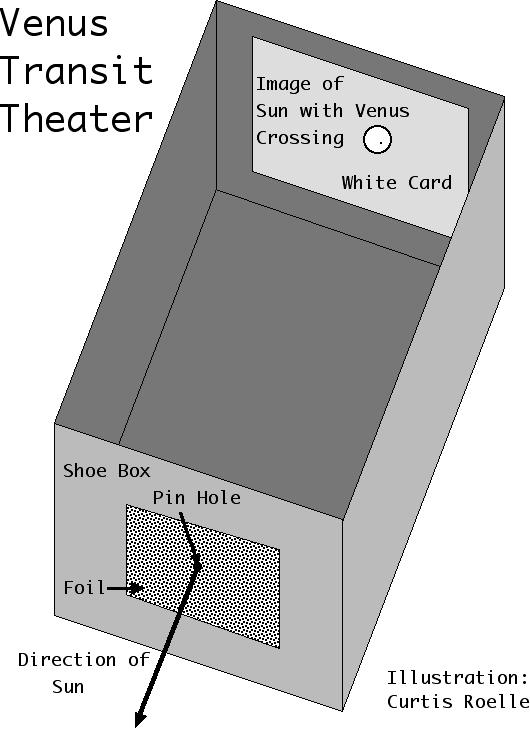
Construct this simple theater to view the Transit of Venus. (Illustration by Curt Roelle).
| Click above image to open larger sized image in new window (48 KB) |
June 5 will be your last chance for over a century to see a transit of Venus. Read on to find out where you can go and how to safely view this rare phenomenon.
The 20th century may have had two world wars and a cold war, but it didnít have any transits of Venus. The next Venus transit doesnít occur until the year 2117 ó 105 years from now.
Transits of Venus occur in pairs with the most recent in 2004 ó the earlier one in the pair that includes this yearís. Yet prior to 2004, the last transit was in 1882 when Chester Arthur was our president. I think it is safe to assume that at the time of the 2004 event, there was not a living soul on Earth who had previously seen a transit of Venus.
Perhaps youíre wondering what a transit of Venus is. It happens when the Sun, Venus, and Earth line up in such a way that we view the tiny dark shadowed disc of Venus crossing the larger and intensely bright disc of the Sun. I will give the starting and ending times for the event later. But first I want to tell you where you can go to see it with your own eyes, weather permitting.
When considering viewing the Sun extreme care must be taken. It is a dangerous proposition without proper precautions and safe reliable equipment. This is where members of Westminsterís own astronomy club are ready to step in and help. The Westminster Astronomical Society will have telescopes equipped for safe solar viewing set up at several different locations.
On Tuesday, June 5, you can go to any of the following Carroll County Public Library branches: North Carroll, Finksburg , Taneytown , Eldersburg , Westminster, and Mt. Airy. The telescopes will be set up by 5:30 p.m., weather permitting. Safe solar viewing glasses will be provided to†the†attendees. In case of clouds, the transit will be viewed on live internet video streams. There will be activities for the entire family.
As for the transit event, the show begins at 6:04 p.m. as the discs of Venus and the Sun appear to touch. A few minutes later a tiny black notch may be visible along the Sunís edge. By 6:21 p.m. Venusí dark disc will be entirely contained within the Sunís own disc. The Sun and Venus will not be actually touching each other. Venus will be about 67 million miles from the Sun, and Earth another 27 million miles from Venus. The circular black dot of Venus drifts slowly across the Sun, and the transit will still be in progress when the Sun sets at 8:32 p.m. EDT.
But what if you cannot make it to any of the library events? Can you watch from home or wherever you happen to be? Yes, you can. You can make a Venus transit theater like the one pictured in the illustration.

Construct this simple theater to view the Transit of Venus. (Illustration by Curt Roelle).
| Click above image to open larger sized image in new window (48 KB) |
Construction is very simple. All you need is 1) an old shoe box, 2) aluminum foil, 3) clear tape, 4) a white card or piece of paper, 5) scissors, and 6) a straight pin.
Cut a hole in one end of the box and cut a piece of aluminum foil big enough to cover the hole. Next, tape the aluminum foil on the inside of the box covering the hole. While you have the tape out, tape a white card or piece of paper inside the box at the opposite end from the foil. Now, with your straight pin carefully make a very small hole in the aluminum foil. Your theater is ready to use.
Here are directions for using it during the transit. 1) Turn your back toward the Sun. 2) Hold the box near your side at waist level with the Sun shining on the outside of the box where the foil is mounted. 3) Turn and tilt box until a pinhole-projected solar image appears on the white card. 4) Look for a tiny black dot on the Sunís projected image. That tiny dot is a planet about the size of Earth.